skip to main |
skip to sidebar
It's hard to accept change. Especially if you're a Yankee fan. I attended Saturday's Reds-Yanks tilt with a die-hard Yankee fan, and he's not alone in his reticence about the stadium situation. This is the last year of the House that Ruth Built, and while the current incarnation bears little resemblance to previous versions, there's still something magical about this place. It may sound irrational, but fans are right in wondering whether the Yanks' unprecedented success here will move to a new place - even if it is within spitting distance of the old one. The Yankees have been selling out nearly every game and it shows in the price of scalped tickets. We had bleacher tickets, but we heard a storm was coming so we looked to upgrade to something under a roof. We ended up paying $70 per seat extra ($20 premium), but it was worth every penny.
The Yankees have been selling out nearly every game and it shows in the price of scalped tickets. We had bleacher tickets, but we heard a storm was coming so we looked to upgrade to something under a roof. We ended up paying $70 per seat extra ($20 premium), but it was worth every penny.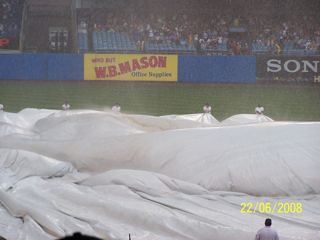 We don't deal with rain delays much in California, which made this particular one quite entertaining. Gale force winds and sideways rain made tarping the infield a bit of an adventure. Worst of all, we were told by people we met after the game that were sitting in the bleachers that during the rain delay, security staff prevented people from getting onto the concourse for safety reasons. Oh yeah, and they don't allow alcohol in the bleachers, so we were able to get our overpriced drink on in the main reserve area as well.
We don't deal with rain delays much in California, which made this particular one quite entertaining. Gale force winds and sideways rain made tarping the infield a bit of an adventure. Worst of all, we were told by people we met after the game that were sitting in the bleachers that during the rain delay, security staff prevented people from getting onto the concourse for safety reasons. Oh yeah, and they don't allow alcohol in the bleachers, so we were able to get our overpriced drink on in the main reserve area as well.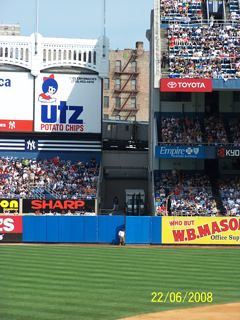 My buddy's house is somewhat upstate and west of the Hudson River. Because of the alcohol factor, we decided to take the train in. Trains west of the Hudson run parallel with Manhattan and terminate at Penn Station (Madison Square Garden). From there we took the B uptown, which dropped us off at the Stadium. No sweat, and by far the best transit situation in baseball (yes, better than the Giants due to frequency of service).
My buddy's house is somewhat upstate and west of the Hudson River. Because of the alcohol factor, we decided to take the train in. Trains west of the Hudson run parallel with Manhattan and terminate at Penn Station (Madison Square Garden). From there we took the B uptown, which dropped us off at the Stadium. No sweat, and by far the best transit situation in baseball (yes, better than the Giants due to frequency of service). There's nothing wrong with the seating bowl, save for the lack of suites and club areas. The seats are wide and spacious. The place holds 57,000 but actually has some intimacy because the decks are stacked on top of each other with good overhangs. It's once you get out of the seating bowl that the deficiencies show. Concourses and ramps are terribly cramped. Available space limits the number and types of concession stands.
There's nothing wrong with the seating bowl, save for the lack of suites and club areas. The seats are wide and spacious. The place holds 57,000 but actually has some intimacy because the decks are stacked on top of each other with good overhangs. It's once you get out of the seating bowl that the deficiencies show. Concourses and ramps are terribly cramped. Available space limits the number and types of concession stands.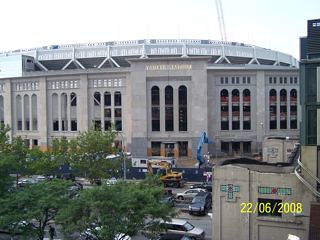 That won't be the case at the New Yankee Stadium, which will be replete with a true façade. Upper deck seats will be further away, and prices will be completely ridiculous. One nice thing that will come out of it: MTA is building a new Metro North train station for fans coming from the Hudson River Valley and Connecticut.
That won't be the case at the New Yankee Stadium, which will be replete with a true façade. Upper deck seats will be further away, and prices will be completely ridiculous. One nice thing that will come out of it: MTA is building a new Metro North train station for fans coming from the Hudson River Valley and Connecticut.
Going into this trip, I was the most wary of the visit to Citizens Bank Park. The 43,000 seat park, which replaced the old Vet in South Philly, has been derided as a Johnny-come-lately bandbox. As another HOK project, I had fairly low expectations of the place. At the end of the night, I found myself pleasantly surprised by the experience.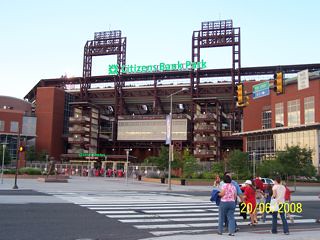 Set in the massive South Philly Sports Complex, Citizens Bank Park is not a downtown ballpark. Yes, it has mass transit (light rail) servicing it, but it's quite clear that the vast majority of its fans arrive by car. And if you came from across the river in Jersey as I did, your choices are limited. Like the Coliseum, CBP is set amongst a vast sea of parking. Yet once come off the Walt Whitman Bridge and descend onto surface streets, there is abundant on-street parking that is predictably free.I entered through the third base gate (pictured above). The gate's immense nature is only a hint at how large and spacious the place is. HOK and local architectural firm Ewing Cole Cherry Brott took advantage of available space. Friday's game against the visiting Angels was a packed sellout, but I didn't feel a crush of fans typical of a sellout.
Set in the massive South Philly Sports Complex, Citizens Bank Park is not a downtown ballpark. Yes, it has mass transit (light rail) servicing it, but it's quite clear that the vast majority of its fans arrive by car. And if you came from across the river in Jersey as I did, your choices are limited. Like the Coliseum, CBP is set amongst a vast sea of parking. Yet once come off the Walt Whitman Bridge and descend onto surface streets, there is abundant on-street parking that is predictably free.I entered through the third base gate (pictured above). The gate's immense nature is only a hint at how large and spacious the place is. HOK and local architectural firm Ewing Cole Cherry Brott took advantage of available space. Friday's game against the visiting Angels was a packed sellout, but I didn't feel a crush of fans typical of a sellout.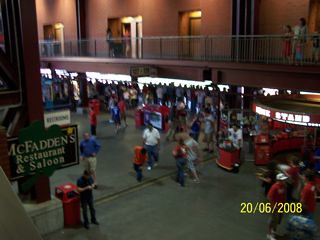 Unlike most other new ballparks, the suite level is hung directly above the field level. The suite level is exclusive but not closed off from the rest of the stadium. This allows for an incredibly high ceiling along the field level concourse. The club level is above the suites and has its own sealed concourse.
Unlike most other new ballparks, the suite level is hung directly above the field level. The suite level is exclusive but not closed off from the rest of the stadium. This allows for an incredibly high ceiling along the field level concourse. The club level is above the suites and has its own sealed concourse.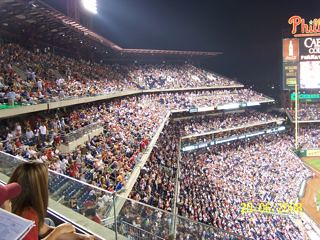 Like the plan for Cisco Field, the upper deck is split into two smaller decks. Doing this provides views of the field from the upper concourse, which is quite good despite the distance from the field. Standing areas with drink rails are all over the place. There's plentiful wheelchair-accessible seating. I'm not sure if HOK came up with the open upper concourse idea, but it's prevalent in their latest designs and they deserve a ton of credit for implementing it.
Like the plan for Cisco Field, the upper deck is split into two smaller decks. Doing this provides views of the field from the upper concourse, which is quite good despite the distance from the field. Standing areas with drink rails are all over the place. There's plentiful wheelchair-accessible seating. I'm not sure if HOK came up with the open upper concourse idea, but it's prevalent in their latest designs and they deserve a ton of credit for implementing it.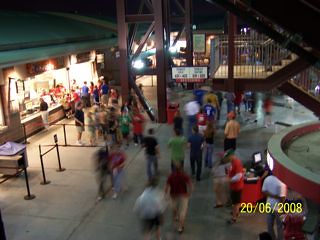 This picture was taken from one of the staircases that leads from the upper concourse to the upper tier. It's a lot of steps to get from the concourse to the upper deck, though not more than from the old upper concourse to the view level of the Coliseum. The execution on a whole is similar to the rebuilt Stanford Stadium.
This picture was taken from one of the staircases that leads from the upper concourse to the upper tier. It's a lot of steps to get from the concourse to the upper deck, though not more than from the old upper concourse to the view level of the Coliseum. The execution on a whole is similar to the rebuilt Stanford Stadium. I had a seat on the second row of the upper tier (section 421). It felt a good deal higher than a similar seat in Oakland. The view was still good. One quirk in the design is the straight, not rounded, backstop. It's little more than an affectation and it makes the place seem that much more boxy and angular. The horizontal line you see cutting through the photo is the top of a plexiglas retaining wall, a line that is actually transparent in live viewing. Notice how for the lower tier of the upper deck, the first row has a stronger metal rail.I'm not a big fan of the pricing structure at CBP. As part of an ugly trend occurring all over MLB, the Phillies are pricing any kind of field level seat as a fairly expensive premium. In older ballparks, it was generally accepted that seats in foul territory would have a premium whereas fair territory seats - typically bleachers - were cheapies. Nowadays, bleachers are something of a relic. Perhaps Cisco Field can buck this trend to some degree, but I'm not counting on it.Speaking of the outfield, I had to visit Ashburn Alley before I left the venue. As mentioned in the last post about Camden Yards, Ashburn Alley is CBP's answer to Eutaw Street. There's an entry gate directly behind it in centerfield. There's a great deal of standing room areas. Restaurants and concessions line the alley, including a Tony Luke's cheesesteak stand (I skipped it and went to the actual Tony Luke's only a few blocks away after the game). It even has a second tier for more standing room and concessions. Despite the high level of activity, it all felt a bit too manufactured, and not terribly authentic. It's the same worry I have about Cisco Field, whose architects (360/Gensler) have their work cut out for them in this regard.
I had a seat on the second row of the upper tier (section 421). It felt a good deal higher than a similar seat in Oakland. The view was still good. One quirk in the design is the straight, not rounded, backstop. It's little more than an affectation and it makes the place seem that much more boxy and angular. The horizontal line you see cutting through the photo is the top of a plexiglas retaining wall, a line that is actually transparent in live viewing. Notice how for the lower tier of the upper deck, the first row has a stronger metal rail.I'm not a big fan of the pricing structure at CBP. As part of an ugly trend occurring all over MLB, the Phillies are pricing any kind of field level seat as a fairly expensive premium. In older ballparks, it was generally accepted that seats in foul territory would have a premium whereas fair territory seats - typically bleachers - were cheapies. Nowadays, bleachers are something of a relic. Perhaps Cisco Field can buck this trend to some degree, but I'm not counting on it.Speaking of the outfield, I had to visit Ashburn Alley before I left the venue. As mentioned in the last post about Camden Yards, Ashburn Alley is CBP's answer to Eutaw Street. There's an entry gate directly behind it in centerfield. There's a great deal of standing room areas. Restaurants and concessions line the alley, including a Tony Luke's cheesesteak stand (I skipped it and went to the actual Tony Luke's only a few blocks away after the game). It even has a second tier for more standing room and concessions. Despite the high level of activity, it all felt a bit too manufactured, and not terribly authentic. It's the same worry I have about Cisco Field, whose architects (360/Gensler) have their work cut out for them in this regard. Despite the manufactured air, one feature of Ashburn Alley made it well worth visiting. Behind the batter's eye in center is a monument to Philadelphia baseball. Not just the Phillies, mind you. Both the Philadelphia A's and Negro League players and teams get nods. The exhibit is set up in two large timelines, the top being the Phillies, the middle for the A's, and the bottom for the Negro Leagues.
Despite the manufactured air, one feature of Ashburn Alley made it well worth visiting. Behind the batter's eye in center is a monument to Philadelphia baseball. Not just the Phillies, mind you. Both the Philadelphia A's and Negro League players and teams get nods. The exhibit is set up in two large timelines, the top being the Phillies, the middle for the A's, and the bottom for the Negro Leagues.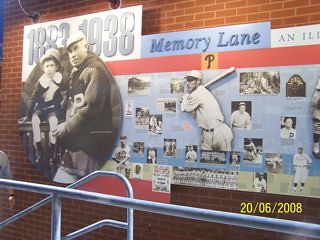
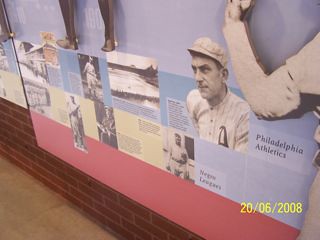
 If you ever visit CBP, this is a must see. With that, I think it's time for me to mention that Lew Wolff brought up the idea of a baseball museum in his initial presentation for the Coliseum North plan, and we haven't heard anything about it since.
If you ever visit CBP, this is a must see. With that, I think it's time for me to mention that Lew Wolff brought up the idea of a baseball museum in his initial presentation for the Coliseum North plan, and we haven't heard anything about it since. Lastly, what visit to a Phillies game would be complete without a mention of the Phanatic? During a break, both male and female Phanatics showed up on the field to enact Philly soul legend Billy Paul's classic "Me and Mrs. Jones." The show included some humorous albeit suggestive belly thrusting on the male Phanatic's part. At the climax, the male took a running start, leaping over the table at which the female was sitting, tackling her in the process.Also, Philly's always had the best between-inning music selections of any ballpark, bar none. Overall, a pretty darned good place to see a game.
Lastly, what visit to a Phillies game would be complete without a mention of the Phanatic? During a break, both male and female Phanatics showed up on the field to enact Philly soul legend Billy Paul's classic "Me and Mrs. Jones." The show included some humorous albeit suggestive belly thrusting on the male Phanatic's part. At the climax, the male took a running start, leaping over the table at which the female was sitting, tackling her in the process.Also, Philly's always had the best between-inning music selections of any ballpark, bar none. Overall, a pretty darned good place to see a game.
Next post: my final visit to Yankee Stadium.
I first visited Camden Yards over a decade ago, when the joint was still new and jumping and the O's were perennial contenders in the AL East. In the intervening years, the team has taken a nosedive and the novelty of having a great downtown ballpark has worn off. This season, the O's have averaged only 27,532 fans per game. After the Nats ballpark tour yesterday, I journeyed up to Baltimore to catch a game and see what other changes were made.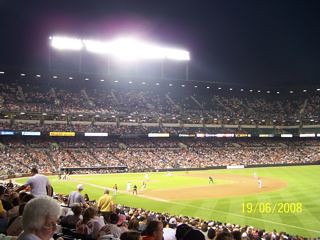 When Oriole Park opened, it put another HOK-designed project, New Comiskey Park, to complete shame. It had open concourses, easy circulation, and that oh-so-retro look. Nowadays, it suffers a bit compared to the newest parks but for the most part still holds it own. That's reflected in the fanbase, much of which is young and comes mostly to hang out.
When Oriole Park opened, it put another HOK-designed project, New Comiskey Park, to complete shame. It had open concourses, easy circulation, and that oh-so-retro look. Nowadays, it suffers a bit compared to the newest parks but for the most part still holds it own. That's reflected in the fanbase, much of which is young and comes mostly to hang out.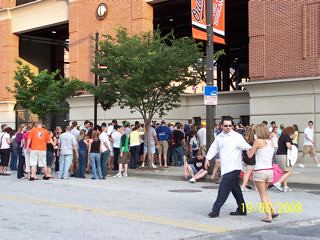 The picture above was taken at 7:36 p.m., over a half hour into the O's-Stros duel. It took me another 20 minutes to get a ticket. By the time I got inside the north Eutaw St gate, it was the middle of the third. The kids in line with me didn't appear to care much for the action on the field, although half the crowd adorned Nick Markakis jersey shirts. The final announced crowd was 31,480, nearly 10,000 more than average. Some of that boost may have been attributable to the team's recent success. The O's were on the verge of a three-game sweep going into Thursday night.
The picture above was taken at 7:36 p.m., over a half hour into the O's-Stros duel. It took me another 20 minutes to get a ticket. By the time I got inside the north Eutaw St gate, it was the middle of the third. The kids in line with me didn't appear to care much for the action on the field, although half the crowd adorned Nick Markakis jersey shirts. The final announced crowd was 31,480, nearly 10,000 more than average. Some of that boost may have been attributable to the team's recent success. The O's were on the verge of a three-game sweep going into Thursday night.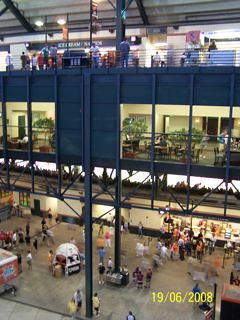 This picture pretty much sums Camden Yards. At the bottom is the field level concourse. Unlike most new ballparks, the tunnels/vomitories from the concourse empty into the middle of the field level seating. You can see the back of the upper section cantilevered over the concourse. The net effect is that fans on the concourse are cut off from the action. It's odd that only baseball really emphasizes the idea of the open concourse, the other three major sports all sport venues with concourses separate from the action. Yet the open concourse really enhances fan experience, that's why even upper decks are getting the treatment.
This picture pretty much sums Camden Yards. At the bottom is the field level concourse. Unlike most new ballparks, the tunnels/vomitories from the concourse empty into the middle of the field level seating. You can see the back of the upper section cantilevered over the concourse. The net effect is that fans on the concourse are cut off from the action. It's odd that only baseball really emphasizes the idea of the open concourse, the other three major sports all sport venues with concourses separate from the action. Yet the open concourse really enhances fan experience, that's why even upper decks are getting the treatment. Now compare the Camden Yards concourse, above, to Nats Park's lower concourse.
Now compare the Camden Yards concourse, above, to Nats Park's lower concourse.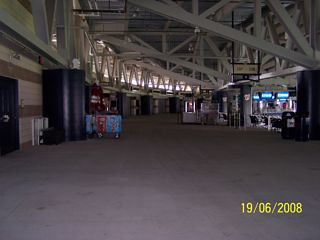 Massive difference in ambient light, right? This tends to make the concourse feel a bit claustrophobic, especially when there's a lot of foot traffic. At Camden Yards, not so much. There's always an available refuge area at the outer edge of the concourse, which happens to be at street level. Is one really that much better than the other? I can't say. Both have readily apparent pros and cons. PETCO Park tried to have it both ways by having concourses split so that they're open on both sides with a block of services in between. I find it a bit confusing.Also, take a look at the structural work. At Camden Yards, the steel beams are smaller but in greater quantity. At Nationals Park they use massive beams and trusses that are set further apart. Is the newer treatment more practical, or more for effect? It gets a big shrug from me. To the same end, Nats Park has huge concrete columns supporting the truss system.The thing I appreciate the most about Camden Yards is its use of materials. All stadium have mixtures of precast concrete and steel, along with some kind of external treatment. While HOK has really emphasized steel in its most recent parks, Camden Yards is different in that it gives equal treatment to both materials, as well as the brick façade.
Massive difference in ambient light, right? This tends to make the concourse feel a bit claustrophobic, especially when there's a lot of foot traffic. At Camden Yards, not so much. There's always an available refuge area at the outer edge of the concourse, which happens to be at street level. Is one really that much better than the other? I can't say. Both have readily apparent pros and cons. PETCO Park tried to have it both ways by having concourses split so that they're open on both sides with a block of services in between. I find it a bit confusing.Also, take a look at the structural work. At Camden Yards, the steel beams are smaller but in greater quantity. At Nationals Park they use massive beams and trusses that are set further apart. Is the newer treatment more practical, or more for effect? It gets a big shrug from me. To the same end, Nats Park has huge concrete columns supporting the truss system.The thing I appreciate the most about Camden Yards is its use of materials. All stadium have mixtures of precast concrete and steel, along with some kind of external treatment. While HOK has really emphasized steel in its most recent parks, Camden Yards is different in that it gives equal treatment to both materials, as well as the brick façade.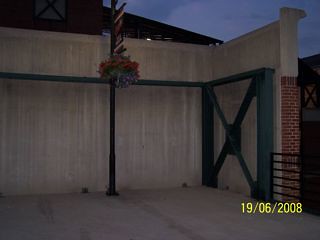 The ramp landing above shows this philosophy. The brick isn't a thin layer as it is at AT&T Park, it's either one or two full bricks deep. It even wraps around so that it's exposed to fans using the ramp. Not to be forgotten, there's a steel form there to remind everyone what's really carrying the load. It's that sense of shared purpose that makes Camden Yards so good, so unique. Sometimes I wonder what's happened to HOK's parks since then. It can't just be a budgetary issue, can it?
The ramp landing above shows this philosophy. The brick isn't a thin layer as it is at AT&T Park, it's either one or two full bricks deep. It even wraps around so that it's exposed to fans using the ramp. Not to be forgotten, there's a steel form there to remind everyone what's really carrying the load. It's that sense of shared purpose that makes Camden Yards so good, so unique. Sometimes I wonder what's happened to HOK's parks since then. It can't just be a budgetary issue, can it? Eutaw Street is the element that every ballpark since then (that has had available space) has tried to copy. It's perfect in terms of execution. Perhaps it's too good. The green canopy in the middle left is the oft-mentioned Boog's BBQ stand. The line for it stretched almost completely to the gate at the far left. Chances are if you were in the line you were waiting for 30 minutes just to order. I'm sure it's good, but really what are they doing? Par-cooking then heating up the food? Is that what they're waiting for?
Eutaw Street is the element that every ballpark since then (that has had available space) has tried to copy. It's perfect in terms of execution. Perhaps it's too good. The green canopy in the middle left is the oft-mentioned Boog's BBQ stand. The line for it stretched almost completely to the gate at the far left. Chances are if you were in the line you were waiting for 30 minutes just to order. I'm sure it's good, but really what are they doing? Par-cooking then heating up the food? Is that what they're waiting for?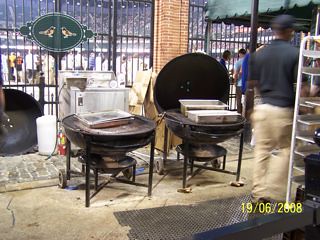 I've been working with a small smoker recently, and much of the time there is no comparison between merely grilled food and truly barbecued (via smokehouse/smoker) food.Tonight I'm off to Citizens Bank Park, home to the Phillies' answer to Eutaw Street, Ashburn Alley.
I've been working with a small smoker recently, and much of the time there is no comparison between merely grilled food and truly barbecued (via smokehouse/smoker) food.Tonight I'm off to Citizens Bank Park, home to the Phillies' answer to Eutaw Street, Ashburn Alley.
A while back I expressed my disappointment at the use of lackluster materials in the Nationals Park façade. Since my flight came into Dulles a little after midnight, I had a chance to quickly drive over to the ballpark in the morning after catching half a wink. It's worse than I thought.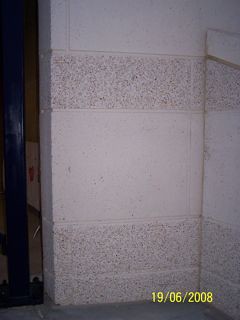 What you're seeing here the wall next to a vehicle service entrance. It has alternating concrete and aggregate. This pattern repeats itself throughout the exterior and provides contrast. No problem if you're looking at it from a distance. Up close, not so great. It doesn't look like it's going to wear or weather well. And unfortunately, there is one place where actual stone is used...
What you're seeing here the wall next to a vehicle service entrance. It has alternating concrete and aggregate. This pattern repeats itself throughout the exterior and provides contrast. No problem if you're looking at it from a distance. Up close, not so great. It doesn't look like it's going to wear or weather well. And unfortunately, there is one place where actual stone is used...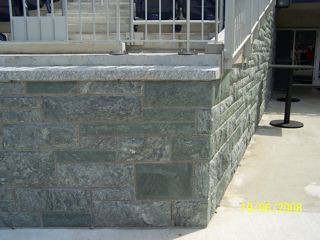 ...the tunnel to the dark, swanky, and very exclusive Lexus Club.
...the tunnel to the dark, swanky, and very exclusive Lexus Club. Years from now Nationals Park will be looked upon as a serviceable, bland venue from the outside. Thankfully, fans will pay a lot more attention to what happens on the inside. Inside, it looks alright. They're still tying up some loose ends, as evidenced by an engineering crew maintaining an office within the stadium.
Years from now Nationals Park will be looked upon as a serviceable, bland venue from the outside. Thankfully, fans will pay a lot more attention to what happens on the inside. Inside, it looks alright. They're still tying up some loose ends, as evidenced by an engineering crew maintaining an office within the stadium. It's not fair to dismiss HOK and Joe Spear for the firm's ubiquitous ballpark design, but they have patterns just like a bad poker player. The fact that they've built so many of these things only magnifies the criticism.Nationals Park shares much with Cincinnati's Great American Ballpark, from the seemingly overbuilt structural steel to the split/uneven upper deck distribution. It certainly pushes the "neighborhood" concept that many (including the A's) are trying to capture. Unfortunately, I think neighborhoods have to come about organically. They can't be forced.Sight lines are good from just about everywhere. Opposing team broadcasters have set about whining their entire stays in DC. To that I can only say that the same thing happened at PNC Park when it opened, and you don't hear that much about the problem anymore - though Nats Park's press box is much higher.
It's not fair to dismiss HOK and Joe Spear for the firm's ubiquitous ballpark design, but they have patterns just like a bad poker player. The fact that they've built so many of these things only magnifies the criticism.Nationals Park shares much with Cincinnati's Great American Ballpark, from the seemingly overbuilt structural steel to the split/uneven upper deck distribution. It certainly pushes the "neighborhood" concept that many (including the A's) are trying to capture. Unfortunately, I think neighborhoods have to come about organically. They can't be forced.Sight lines are good from just about everywhere. Opposing team broadcasters have set about whining their entire stays in DC. To that I can only say that the same thing happened at PNC Park when it opened, and you don't hear that much about the problem anymore - though Nats Park's press box is much higher.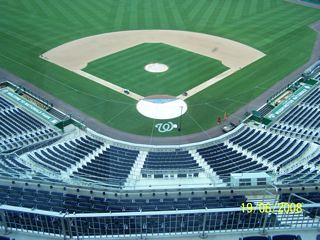 The Mitsubishi scoreboard looks good. In a puzzling bit of advertising wizardry, Amtrak is the sponsor on all in-house displays. Now I'm not sure if that's only when there isn't a game on. If that's the case it's a curious way to get eyeballs.The field level concourse is enormous and easy to navigate. They've used the space well to spread out food and entertainment offerings, right down to a large, multi-attraction children's area in RF.I will be returning to Nationals Park on the 27th and 28th for games against the Orioles. I'll look at transportation and parking, along with understanding how the design elements work practically in service of the fans. FWIW it took 40 minutes to take the Metrorail's Green Line train between the Navy Yard station (1/2 block from Nationals Park) and the Greenbelt station, which is in Maryland beyond the Beltway and College Park, the home of the University of Maryland. It also took 3 minutes from L'Enfant Plaza.Tomorrow, I'll write the nightcap from the 19th: a visit to a game at Camden Yards.
The Mitsubishi scoreboard looks good. In a puzzling bit of advertising wizardry, Amtrak is the sponsor on all in-house displays. Now I'm not sure if that's only when there isn't a game on. If that's the case it's a curious way to get eyeballs.The field level concourse is enormous and easy to navigate. They've used the space well to spread out food and entertainment offerings, right down to a large, multi-attraction children's area in RF.I will be returning to Nationals Park on the 27th and 28th for games against the Orioles. I'll look at transportation and parking, along with understanding how the design elements work practically in service of the fans. FWIW it took 40 minutes to take the Metrorail's Green Line train between the Navy Yard station (1/2 block from Nationals Park) and the Greenbelt station, which is in Maryland beyond the Beltway and College Park, the home of the University of Maryland. It also took 3 minutes from L'Enfant Plaza.Tomorrow, I'll write the nightcap from the 19th: a visit to a game at Camden Yards.
Ah, process.Santa Clara's city council is considering pushing the stadium financing plan's deadline back seven months, which would make a November vote impossible. The next likely election is a special election in mid-to-late 2009, in which a much lower turnout would be expected than the upcoming general election. Usually this is good for stadium proponents as they can expect and gear up a greater percentage of turnout from their supporters than their opponents.Even with that there's still the EIR that has to be completed. While far less complicated than the Cisco Field/baseball village EIR, there's still a year's worth of work there. Proponents still claim that a 2012 opening is still possible, but they're cutting it really close.One potentially troubling item comes from councilmember and stadium skeptic Jamie Mcleod, who states:...the 49ers have pledged only to cover cost overruns for one year after the team's 2012 completion target.
No big deal if they get it done on time and do some value engineering in the process. Because they might value engineer the first time around, they might use up a lot of that annual stadium improvement fund quickly, lest the 49ers stadium turn into Edward Jones Dome.
San Francisco voters passed Proposition G while nixing Proposition F. Prop G asked for voter approval of Lennar's vast Hunters Point development. Prop F would have added that half of the new housing to be built had to be affordable housing. As part of the development plan, Lennar has set aside a site for a new 49ers stadium to replace the 'Stick, while also ponying up $100 million towards construction.Meanwhile, competing statewide anti-eminent domain Propositions 98 and 99 were also on the ballot. Prop 98 lost, while Prop 99 won. The upshot is that the state now has a real, though limited, set of restrictions against eminent domain. Homeowners will be protected against property seizures intended for use by private parties (developers). However, this really only brings us back to the original purpose of eminent domain: seizure of property for public use (roads, etc.). A city or county could continue to seize property to build, say, a stadium, and as long as the final product were publicly owned it would still pass muster. Whoop-de-do!




























